International Tourism System: Pokhara Tourism Development Analysis
VerifiedAdded on 2022/09/09
|12
|4017
|20
Report
AI Summary
This report offers a comprehensive analysis of the international tourism system in Pokhara, Nepal. It begins with an introduction to the destination and its key themes, followed by an overview of the historical development of tourism in Pokhara, highlighting its evolution from a waypoint for climbers to a popular destination for various activities. The report then analyzes international tourism visitation, emphasizing the city's strategic position and infrastructure amenities. It identifies the factors that make Pokhara attractive to tourists, including natural beauty, cultural heritage, and adventure opportunities. The report critically examines the impacts of tourism on the host community, focusing on economic, adventure, religious, and business aspects. Furthermore, it identifies and explains two key destination development issues: sustainable mountain tourism development, including issues related to permit systems, infrastructure, royalty fees, and transportation facilities. The report concludes with a summary of the findings and provides valuable insights into the challenges and opportunities facing tourism in Pokhara.

International tourism system
Paraphrase This Document
Need a fresh take? Get an instant paraphrase of this document with our AI Paraphraser
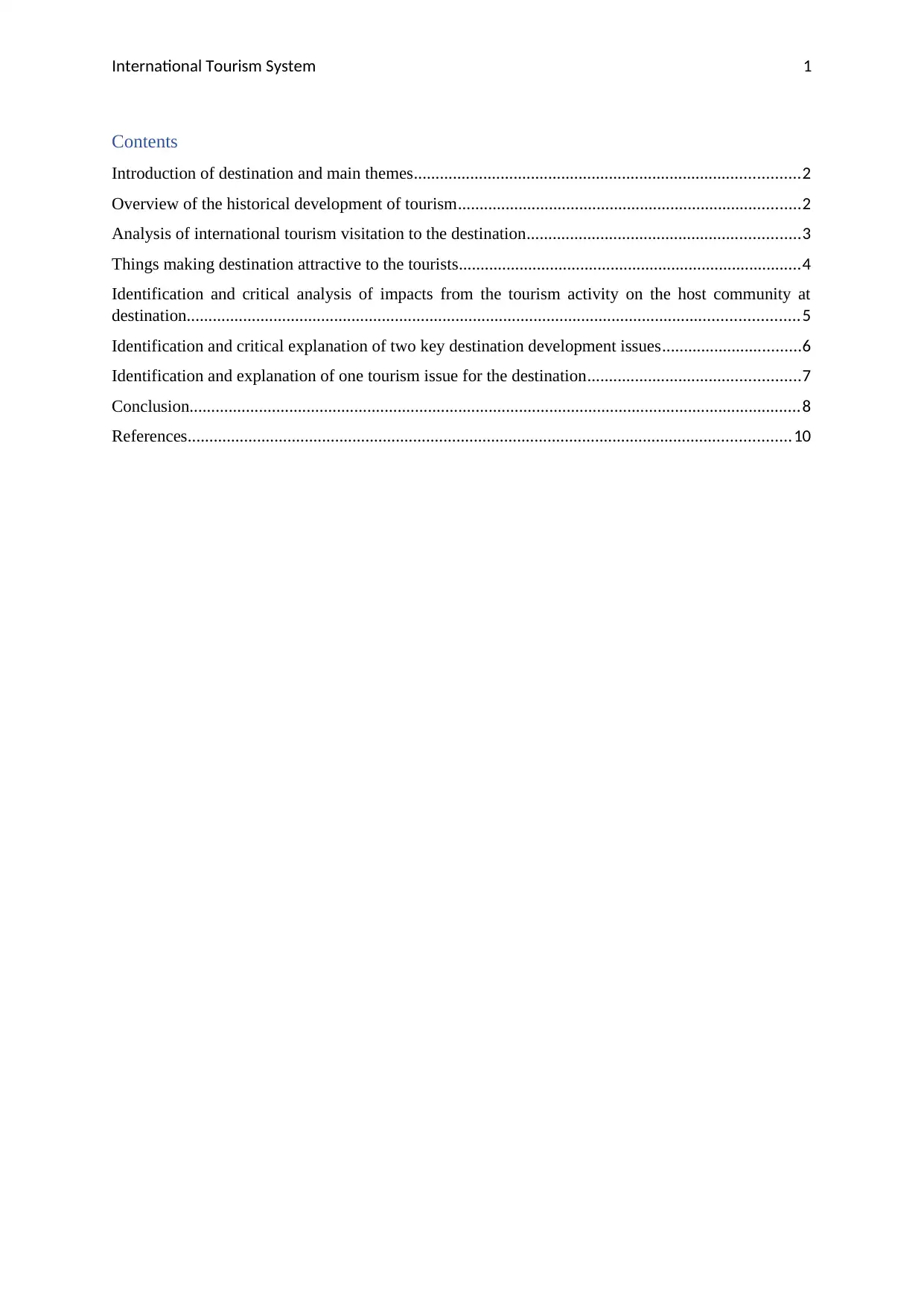
International Tourism System 1
Contents
Introduction of destination and main themes.........................................................................................2
Overview of the historical development of tourism...............................................................................2
Analysis of international tourism visitation to the destination...............................................................3
Things making destination attractive to the tourists...............................................................................4
Identification and critical analysis of impacts from the tourism activity on the host community at
destination.............................................................................................................................................5
Identification and critical explanation of two key destination development issues................................6
Identification and explanation of one tourism issue for the destination.................................................7
Conclusion.............................................................................................................................................8
References...........................................................................................................................................10
Contents
Introduction of destination and main themes.........................................................................................2
Overview of the historical development of tourism...............................................................................2
Analysis of international tourism visitation to the destination...............................................................3
Things making destination attractive to the tourists...............................................................................4
Identification and critical analysis of impacts from the tourism activity on the host community at
destination.............................................................................................................................................5
Identification and critical explanation of two key destination development issues................................6
Identification and explanation of one tourism issue for the destination.................................................7
Conclusion.............................................................................................................................................8
References...........................................................................................................................................10

International Tourism System 2
Introduction of destination and main themes
The tourism system is viewed as cultural, social and economic practices that demand the
activity of persons from the customary place to alternative place for the corporate, shopping,
leave and other purposes. The tourism industry has a great role in the overall development of
the nation. This report includes the prospects of tourism in Pokhara. An overview has been
provided for the historical advancement of tourism in Pokhara along with international
tourism visitation. The features making attractive to the destination has been explained.
Further, the influences of tourism activity on the host communal have been stated. The report
has also included 2 vital destination advancement issues with the 1 tourism policy matter in
the destination.
Overview of the historical development of tourism
Pokhara is identified as the best touristic hub in Nepal. Pokhara is 2nd largest city in Nepal
and is 200 km away from Kathmandu. There is no specific record of tourism in Nepal before
the consensus in 1951. Preceding to democracy, Nepal was not opened for the tourists but the
rise of democracy, social, political and economic features has opened the door for the tourists
to visit Pokhara. The city is having geographical diversity with a unique climate. Pokhara has
a variety of structure which is anticipated within the difference of weather and climate
concurrently. Tourism in Pokhara began with mountain tourism (Upadhyay, 2019). From the
1950s to the 1960s, Pokhara was recognized for its waypoint for the climbers. Mount
Annapurna was identified as the first momentous climbing in 1950 by French national
Maurice Herzog and the team. Pokhara is also known for hippy’s favorite place and their
photography made Pokhara famous worldwide. Things such as a sequence of actions and
successive antique inclinations made Pokhara a famous destination in Nepal (Anwar, 2016).
Mountain tourism has a excessive role in the tourism development of Pokhara. Other than
this, the tourism activities such as trekking, hiking, rafting, jungle safari, national wildlife
parks, legacy sites, stunning temples, and natural sites make Pokhara a popular destination.
Once Pokhara was known for just mountain tourist but at present, it is at the top of the
admiration of several features and a mounting number of tourists. In 1961, the tourism
information center was formed and developed a draft of a corporeal advancement plan. It
became a milestone for tourism advancement in the city. In 1968, Siddhartha highway was
established to connect Pokhara with the external world. Such a linking augmented the
movement of tourists in Pokhara (Beames, Mackie and Atencio, 2019). In the late 1970s, the
Introduction of destination and main themes
The tourism system is viewed as cultural, social and economic practices that demand the
activity of persons from the customary place to alternative place for the corporate, shopping,
leave and other purposes. The tourism industry has a great role in the overall development of
the nation. This report includes the prospects of tourism in Pokhara. An overview has been
provided for the historical advancement of tourism in Pokhara along with international
tourism visitation. The features making attractive to the destination has been explained.
Further, the influences of tourism activity on the host communal have been stated. The report
has also included 2 vital destination advancement issues with the 1 tourism policy matter in
the destination.
Overview of the historical development of tourism
Pokhara is identified as the best touristic hub in Nepal. Pokhara is 2nd largest city in Nepal
and is 200 km away from Kathmandu. There is no specific record of tourism in Nepal before
the consensus in 1951. Preceding to democracy, Nepal was not opened for the tourists but the
rise of democracy, social, political and economic features has opened the door for the tourists
to visit Pokhara. The city is having geographical diversity with a unique climate. Pokhara has
a variety of structure which is anticipated within the difference of weather and climate
concurrently. Tourism in Pokhara began with mountain tourism (Upadhyay, 2019). From the
1950s to the 1960s, Pokhara was recognized for its waypoint for the climbers. Mount
Annapurna was identified as the first momentous climbing in 1950 by French national
Maurice Herzog and the team. Pokhara is also known for hippy’s favorite place and their
photography made Pokhara famous worldwide. Things such as a sequence of actions and
successive antique inclinations made Pokhara a famous destination in Nepal (Anwar, 2016).
Mountain tourism has a excessive role in the tourism development of Pokhara. Other than
this, the tourism activities such as trekking, hiking, rafting, jungle safari, national wildlife
parks, legacy sites, stunning temples, and natural sites make Pokhara a popular destination.
Once Pokhara was known for just mountain tourist but at present, it is at the top of the
admiration of several features and a mounting number of tourists. In 1961, the tourism
information center was formed and developed a draft of a corporeal advancement plan. It
became a milestone for tourism advancement in the city. In 1968, Siddhartha highway was
established to connect Pokhara with the external world. Such a linking augmented the
movement of tourists in Pokhara (Beames, Mackie and Atencio, 2019). In the late 1970s, the
⊘ This is a preview!⊘
Do you want full access?
Subscribe today to unlock all pages.

Trusted by 1+ million students worldwide
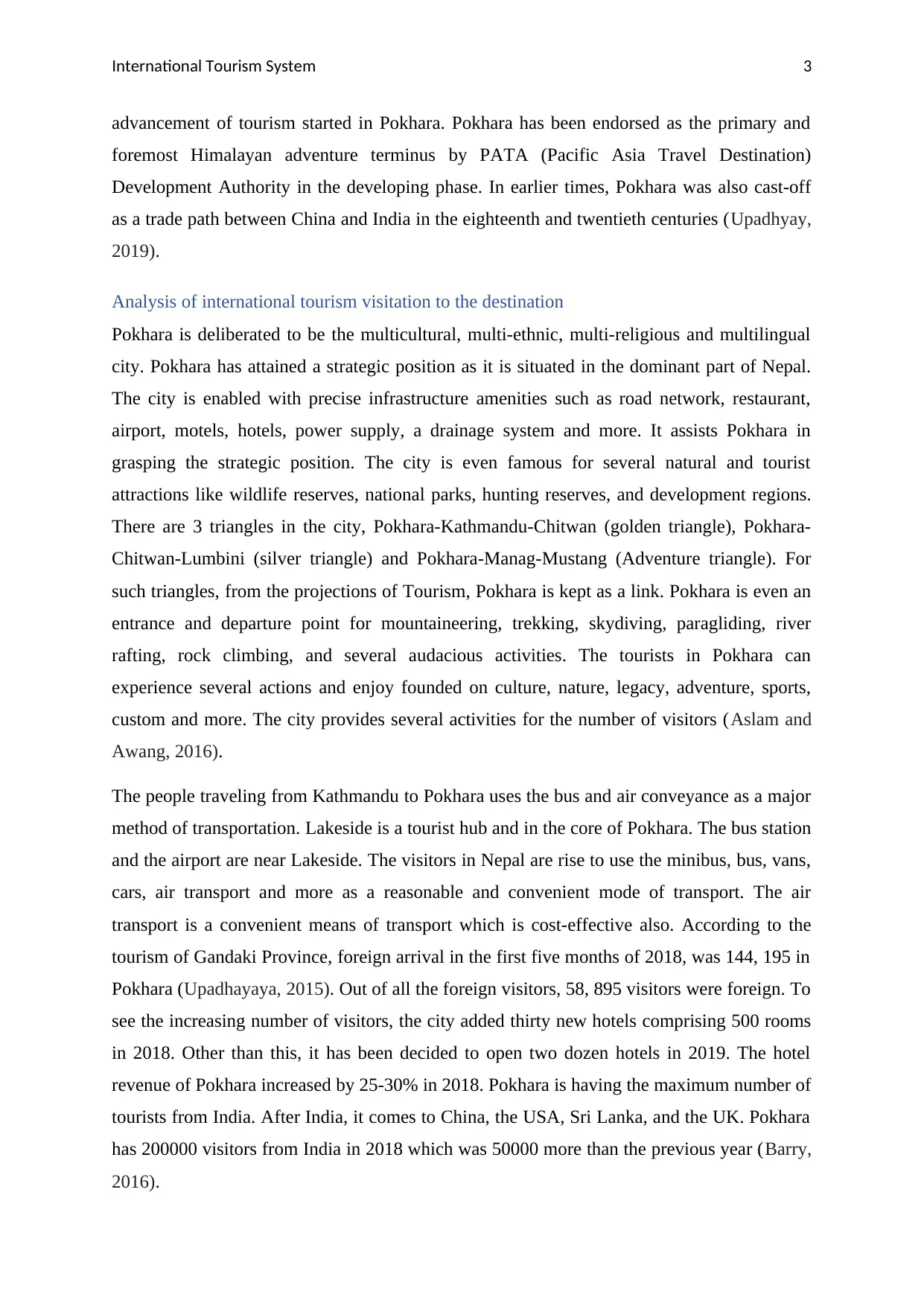
International Tourism System 3
advancement of tourism started in Pokhara. Pokhara has been endorsed as the primary and
foremost Himalayan adventure terminus by PATA (Pacific Asia Travel Destination)
Development Authority in the developing phase. In earlier times, Pokhara was also cast-off
as a trade path between China and India in the eighteenth and twentieth centuries (Upadhyay,
2019).
Analysis of international tourism visitation to the destination
Pokhara is deliberated to be the multicultural, multi-ethnic, multi-religious and multilingual
city. Pokhara has attained a strategic position as it is situated in the dominant part of Nepal.
The city is enabled with precise infrastructure amenities such as road network, restaurant,
airport, motels, hotels, power supply, a drainage system and more. It assists Pokhara in
grasping the strategic position. The city is even famous for several natural and tourist
attractions like wildlife reserves, national parks, hunting reserves, and development regions.
There are 3 triangles in the city, Pokhara-Kathmandu-Chitwan (golden triangle), Pokhara-
Chitwan-Lumbini (silver triangle) and Pokhara-Manag-Mustang (Adventure triangle). For
such triangles, from the projections of Tourism, Pokhara is kept as a link. Pokhara is even an
entrance and departure point for mountaineering, trekking, skydiving, paragliding, river
rafting, rock climbing, and several audacious activities. The tourists in Pokhara can
experience several actions and enjoy founded on culture, nature, legacy, adventure, sports,
custom and more. The city provides several activities for the number of visitors (Aslam and
Awang, 2016).
The people traveling from Kathmandu to Pokhara uses the bus and air conveyance as a major
method of transportation. Lakeside is a tourist hub and in the core of Pokhara. The bus station
and the airport are near Lakeside. The visitors in Nepal are rise to use the minibus, bus, vans,
cars, air transport and more as a reasonable and convenient mode of transport. The air
transport is a convenient means of transport which is cost-effective also. According to the
tourism of Gandaki Province, foreign arrival in the first five months of 2018, was 144, 195 in
Pokhara (Upadhayaya, 2015). Out of all the foreign visitors, 58, 895 visitors were foreign. To
see the increasing number of visitors, the city added thirty new hotels comprising 500 rooms
in 2018. Other than this, it has been decided to open two dozen hotels in 2019. The hotel
revenue of Pokhara increased by 25-30% in 2018. Pokhara is having the maximum number of
tourists from India. After India, it comes to China, the USA, Sri Lanka, and the UK. Pokhara
has 200000 visitors from India in 2018 which was 50000 more than the previous year (Barry,
2016).
advancement of tourism started in Pokhara. Pokhara has been endorsed as the primary and
foremost Himalayan adventure terminus by PATA (Pacific Asia Travel Destination)
Development Authority in the developing phase. In earlier times, Pokhara was also cast-off
as a trade path between China and India in the eighteenth and twentieth centuries (Upadhyay,
2019).
Analysis of international tourism visitation to the destination
Pokhara is deliberated to be the multicultural, multi-ethnic, multi-religious and multilingual
city. Pokhara has attained a strategic position as it is situated in the dominant part of Nepal.
The city is enabled with precise infrastructure amenities such as road network, restaurant,
airport, motels, hotels, power supply, a drainage system and more. It assists Pokhara in
grasping the strategic position. The city is even famous for several natural and tourist
attractions like wildlife reserves, national parks, hunting reserves, and development regions.
There are 3 triangles in the city, Pokhara-Kathmandu-Chitwan (golden triangle), Pokhara-
Chitwan-Lumbini (silver triangle) and Pokhara-Manag-Mustang (Adventure triangle). For
such triangles, from the projections of Tourism, Pokhara is kept as a link. Pokhara is even an
entrance and departure point for mountaineering, trekking, skydiving, paragliding, river
rafting, rock climbing, and several audacious activities. The tourists in Pokhara can
experience several actions and enjoy founded on culture, nature, legacy, adventure, sports,
custom and more. The city provides several activities for the number of visitors (Aslam and
Awang, 2016).
The people traveling from Kathmandu to Pokhara uses the bus and air conveyance as a major
method of transportation. Lakeside is a tourist hub and in the core of Pokhara. The bus station
and the airport are near Lakeside. The visitors in Nepal are rise to use the minibus, bus, vans,
cars, air transport and more as a reasonable and convenient mode of transport. The air
transport is a convenient means of transport which is cost-effective also. According to the
tourism of Gandaki Province, foreign arrival in the first five months of 2018, was 144, 195 in
Pokhara (Upadhayaya, 2015). Out of all the foreign visitors, 58, 895 visitors were foreign. To
see the increasing number of visitors, the city added thirty new hotels comprising 500 rooms
in 2018. Other than this, it has been decided to open two dozen hotels in 2019. The hotel
revenue of Pokhara increased by 25-30% in 2018. Pokhara is having the maximum number of
tourists from India. After India, it comes to China, the USA, Sri Lanka, and the UK. Pokhara
has 200000 visitors from India in 2018 which was 50000 more than the previous year (Barry,
2016).
Paraphrase This Document
Need a fresh take? Get an instant paraphrase of this document with our AI Paraphraser
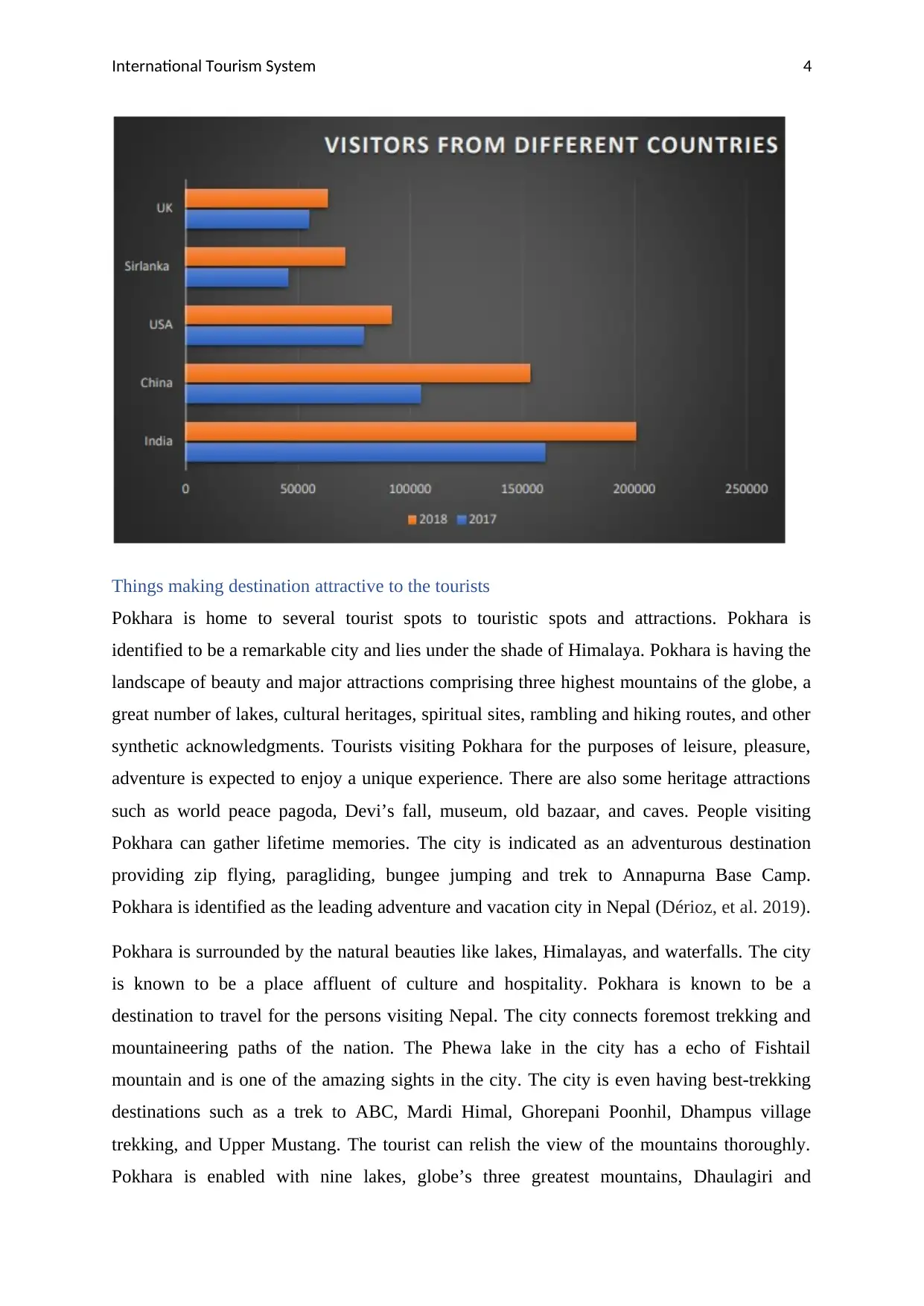
International Tourism System 4
Things making destination attractive to the tourists
Pokhara is home to several tourist spots to touristic spots and attractions. Pokhara is
identified to be a remarkable city and lies under the shade of Himalaya. Pokhara is having the
landscape of beauty and major attractions comprising three highest mountains of the globe, a
great number of lakes, cultural heritages, spiritual sites, rambling and hiking routes, and other
synthetic acknowledgments. Tourists visiting Pokhara for the purposes of leisure, pleasure,
adventure is expected to enjoy a unique experience. There are also some heritage attractions
such as world peace pagoda, Devi’s fall, museum, old bazaar, and caves. People visiting
Pokhara can gather lifetime memories. The city is indicated as an adventurous destination
providing zip flying, paragliding, bungee jumping and trek to Annapurna Base Camp.
Pokhara is identified as the leading adventure and vacation city in Nepal (Dérioz, et al. 2019).
Pokhara is surrounded by the natural beauties like lakes, Himalayas, and waterfalls. The city
is known to be a place affluent of culture and hospitality. Pokhara is known to be a
destination to travel for the persons visiting Nepal. The city connects foremost trekking and
mountaineering paths of the nation. The Phewa lake in the city has a echo of Fishtail
mountain and is one of the amazing sights in the city. The city is even having best-trekking
destinations such as a trek to ABC, Mardi Himal, Ghorepani Poonhil, Dhampus village
trekking, and Upper Mustang. The tourist can relish the view of the mountains thoroughly.
Pokhara is enabled with nine lakes, globe’s three greatest mountains, Dhaulagiri and
Things making destination attractive to the tourists
Pokhara is home to several tourist spots to touristic spots and attractions. Pokhara is
identified to be a remarkable city and lies under the shade of Himalaya. Pokhara is having the
landscape of beauty and major attractions comprising three highest mountains of the globe, a
great number of lakes, cultural heritages, spiritual sites, rambling and hiking routes, and other
synthetic acknowledgments. Tourists visiting Pokhara for the purposes of leisure, pleasure,
adventure is expected to enjoy a unique experience. There are also some heritage attractions
such as world peace pagoda, Devi’s fall, museum, old bazaar, and caves. People visiting
Pokhara can gather lifetime memories. The city is indicated as an adventurous destination
providing zip flying, paragliding, bungee jumping and trek to Annapurna Base Camp.
Pokhara is identified as the leading adventure and vacation city in Nepal (Dérioz, et al. 2019).
Pokhara is surrounded by the natural beauties like lakes, Himalayas, and waterfalls. The city
is known to be a place affluent of culture and hospitality. Pokhara is known to be a
destination to travel for the persons visiting Nepal. The city connects foremost trekking and
mountaineering paths of the nation. The Phewa lake in the city has a echo of Fishtail
mountain and is one of the amazing sights in the city. The city is even having best-trekking
destinations such as a trek to ABC, Mardi Himal, Ghorepani Poonhil, Dhampus village
trekking, and Upper Mustang. The tourist can relish the view of the mountains thoroughly.
Pokhara is enabled with nine lakes, globe’s three greatest mountains, Dhaulagiri and
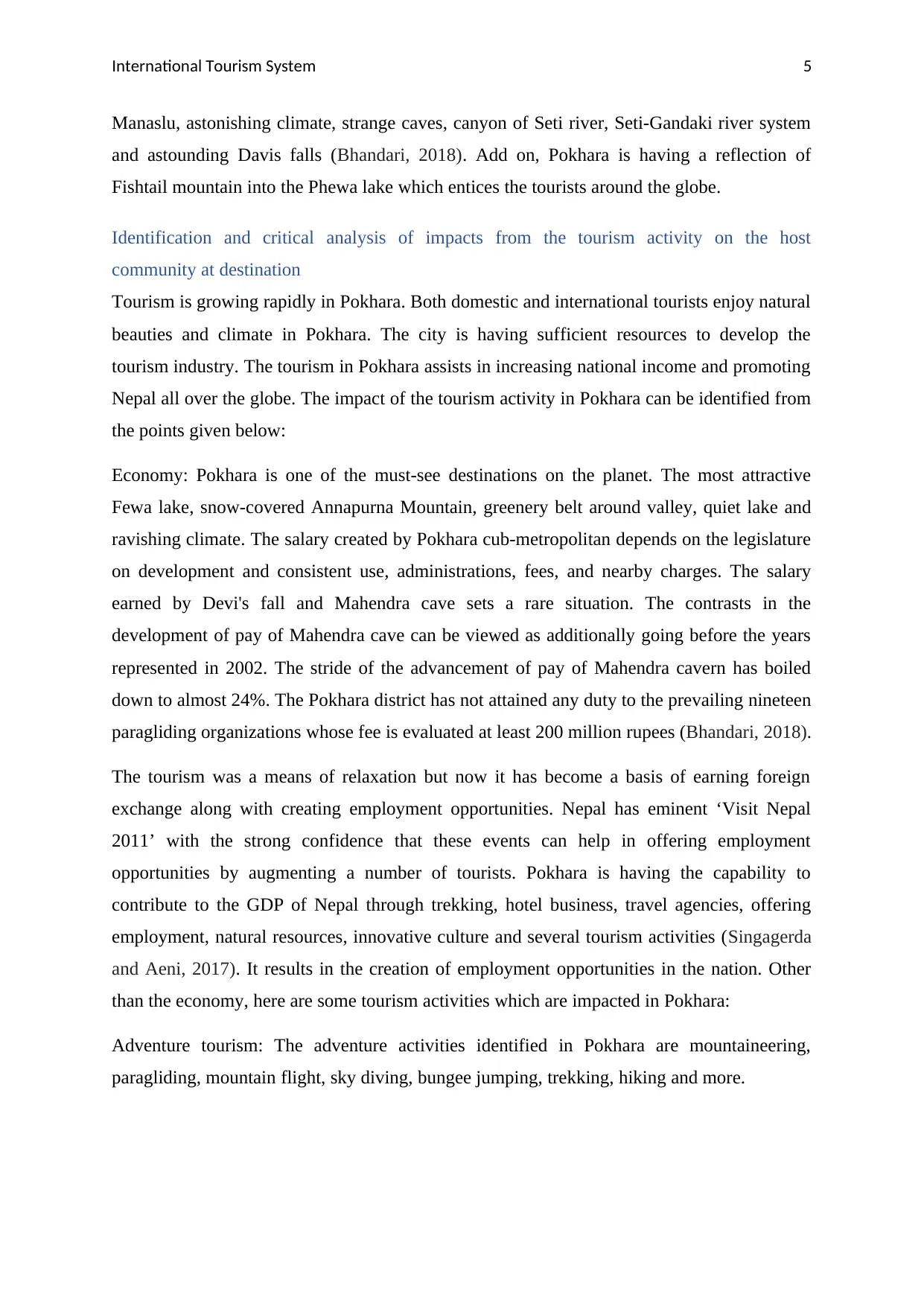
International Tourism System 5
Manaslu, astonishing climate, strange caves, canyon of Seti river, Seti-Gandaki river system
and astounding Davis falls (Bhandari, 2018). Add on, Pokhara is having a reflection of
Fishtail mountain into the Phewa lake which entices the tourists around the globe.
Identification and critical analysis of impacts from the tourism activity on the host
community at destination
Tourism is growing rapidly in Pokhara. Both domestic and international tourists enjoy natural
beauties and climate in Pokhara. The city is having sufficient resources to develop the
tourism industry. The tourism in Pokhara assists in increasing national income and promoting
Nepal all over the globe. The impact of the tourism activity in Pokhara can be identified from
the points given below:
Economy: Pokhara is one of the must-see destinations on the planet. The most attractive
Fewa lake, snow-covered Annapurna Mountain, greenery belt around valley, quiet lake and
ravishing climate. The salary created by Pokhara cub-metropolitan depends on the legislature
on development and consistent use, administrations, fees, and nearby charges. The salary
earned by Devi's fall and Mahendra cave sets a rare situation. The contrasts in the
development of pay of Mahendra cave can be viewed as additionally going before the years
represented in 2002. The stride of the advancement of pay of Mahendra cavern has boiled
down to almost 24%. The Pokhara district has not attained any duty to the prevailing nineteen
paragliding organizations whose fee is evaluated at least 200 million rupees (Bhandari, 2018).
The tourism was a means of relaxation but now it has become a basis of earning foreign
exchange along with creating employment opportunities. Nepal has eminent ‘Visit Nepal
2011’ with the strong confidence that these events can help in offering employment
opportunities by augmenting a number of tourists. Pokhara is having the capability to
contribute to the GDP of Nepal through trekking, hotel business, travel agencies, offering
employment, natural resources, innovative culture and several tourism activities (Singagerda
and Aeni, 2017). It results in the creation of employment opportunities in the nation. Other
than the economy, here are some tourism activities which are impacted in Pokhara:
Adventure tourism: The adventure activities identified in Pokhara are mountaineering,
paragliding, mountain flight, sky diving, bungee jumping, trekking, hiking and more.
Manaslu, astonishing climate, strange caves, canyon of Seti river, Seti-Gandaki river system
and astounding Davis falls (Bhandari, 2018). Add on, Pokhara is having a reflection of
Fishtail mountain into the Phewa lake which entices the tourists around the globe.
Identification and critical analysis of impacts from the tourism activity on the host
community at destination
Tourism is growing rapidly in Pokhara. Both domestic and international tourists enjoy natural
beauties and climate in Pokhara. The city is having sufficient resources to develop the
tourism industry. The tourism in Pokhara assists in increasing national income and promoting
Nepal all over the globe. The impact of the tourism activity in Pokhara can be identified from
the points given below:
Economy: Pokhara is one of the must-see destinations on the planet. The most attractive
Fewa lake, snow-covered Annapurna Mountain, greenery belt around valley, quiet lake and
ravishing climate. The salary created by Pokhara cub-metropolitan depends on the legislature
on development and consistent use, administrations, fees, and nearby charges. The salary
earned by Devi's fall and Mahendra cave sets a rare situation. The contrasts in the
development of pay of Mahendra cave can be viewed as additionally going before the years
represented in 2002. The stride of the advancement of pay of Mahendra cavern has boiled
down to almost 24%. The Pokhara district has not attained any duty to the prevailing nineteen
paragliding organizations whose fee is evaluated at least 200 million rupees (Bhandari, 2018).
The tourism was a means of relaxation but now it has become a basis of earning foreign
exchange along with creating employment opportunities. Nepal has eminent ‘Visit Nepal
2011’ with the strong confidence that these events can help in offering employment
opportunities by augmenting a number of tourists. Pokhara is having the capability to
contribute to the GDP of Nepal through trekking, hotel business, travel agencies, offering
employment, natural resources, innovative culture and several tourism activities (Singagerda
and Aeni, 2017). It results in the creation of employment opportunities in the nation. Other
than the economy, here are some tourism activities which are impacted in Pokhara:
Adventure tourism: The adventure activities identified in Pokhara are mountaineering,
paragliding, mountain flight, sky diving, bungee jumping, trekking, hiking and more.
⊘ This is a preview!⊘
Do you want full access?
Subscribe today to unlock all pages.

Trusted by 1+ million students worldwide

International Tourism System 6
Religious and cultural tourism: Tourism activity also influences religious tourism. There are
different holy places advanced as religious tourism places. The cultural and heritage sites
have initiated to cultural tourism (Genç, 2018).
Leisure tourism: The leisure tourism in Pokhara identified as rafting, kayaking, trekking,
paragliding, hiking and more.
Wellness tourism: Wellness tourism comprises yoga and meditation. Wellness tourism in the
city has formed a balanced life as a regular momentum.
Business tourism: The tourism activities have benefited the business in Pokhara. Tourism has
led to economic growth in the form of creating employment opportunities (Devkota, et al.
2019).
Identification and critical clarification of two key destination development issues
The diversified culture and biodiversity have a great role in the tourism potentiality of
Pokhara. The key destination development issues faced by Pokhara in the form of sustainable
mountain tourism development. The issues are faced concerning efforts specifically
mountaineering expeditions and trekking. Such issues are required to be addressed in the
form of the compound permit system, weak infrastructure, royalty fees, mounting pressure on
popular mountains, pollution, overcrowding, lack of innovative equipment for
mountaineering, commercialization of mountains, accidents and inexperienced climbers. It is
quite composite to get an authorized certification for mountaineering and completing other
regulations. It is required to visit several ministries and offices for the permit. It becomes
quite annoying and time-consuming (Joshi and Dahal, 2019). If the issuance of the several
licenses necessitated for mountaineering is accomplished through one office at the base camp
then the procedure will become simpler along with the time-saving. Add on, the voyage
royalty fee in Pokhara is quite exclusive. The operating costs required for attaining peaks
concerning voyage teams are quite high. Therefore, the voyage teams have to suffer the cost
of liaison officer so the voyage costs run great. On the other side, Nepal has not been
successful in reaping the assistances of appealing a superior number of mountaineers which
creates a substantial problem in sustain mountain tourism development. The voyage royalty
fees shared border mountains are quite less in India and China than secure in Nepal. As per
the report of Nepal, the amount of royalty attained has also lessened in 2016 as compared to
the previous years. It also puts an impact on the royalty to be attained in the coming years.
Religious and cultural tourism: Tourism activity also influences religious tourism. There are
different holy places advanced as religious tourism places. The cultural and heritage sites
have initiated to cultural tourism (Genç, 2018).
Leisure tourism: The leisure tourism in Pokhara identified as rafting, kayaking, trekking,
paragliding, hiking and more.
Wellness tourism: Wellness tourism comprises yoga and meditation. Wellness tourism in the
city has formed a balanced life as a regular momentum.
Business tourism: The tourism activities have benefited the business in Pokhara. Tourism has
led to economic growth in the form of creating employment opportunities (Devkota, et al.
2019).
Identification and critical clarification of two key destination development issues
The diversified culture and biodiversity have a great role in the tourism potentiality of
Pokhara. The key destination development issues faced by Pokhara in the form of sustainable
mountain tourism development. The issues are faced concerning efforts specifically
mountaineering expeditions and trekking. Such issues are required to be addressed in the
form of the compound permit system, weak infrastructure, royalty fees, mounting pressure on
popular mountains, pollution, overcrowding, lack of innovative equipment for
mountaineering, commercialization of mountains, accidents and inexperienced climbers. It is
quite composite to get an authorized certification for mountaineering and completing other
regulations. It is required to visit several ministries and offices for the permit. It becomes
quite annoying and time-consuming (Joshi and Dahal, 2019). If the issuance of the several
licenses necessitated for mountaineering is accomplished through one office at the base camp
then the procedure will become simpler along with the time-saving. Add on, the voyage
royalty fee in Pokhara is quite exclusive. The operating costs required for attaining peaks
concerning voyage teams are quite high. Therefore, the voyage teams have to suffer the cost
of liaison officer so the voyage costs run great. On the other side, Nepal has not been
successful in reaping the assistances of appealing a superior number of mountaineers which
creates a substantial problem in sustain mountain tourism development. The voyage royalty
fees shared border mountains are quite less in India and China than secure in Nepal. As per
the report of Nepal, the amount of royalty attained has also lessened in 2016 as compared to
the previous years. It also puts an impact on the royalty to be attained in the coming years.
Paraphrase This Document
Need a fresh take? Get an instant paraphrase of this document with our AI Paraphraser
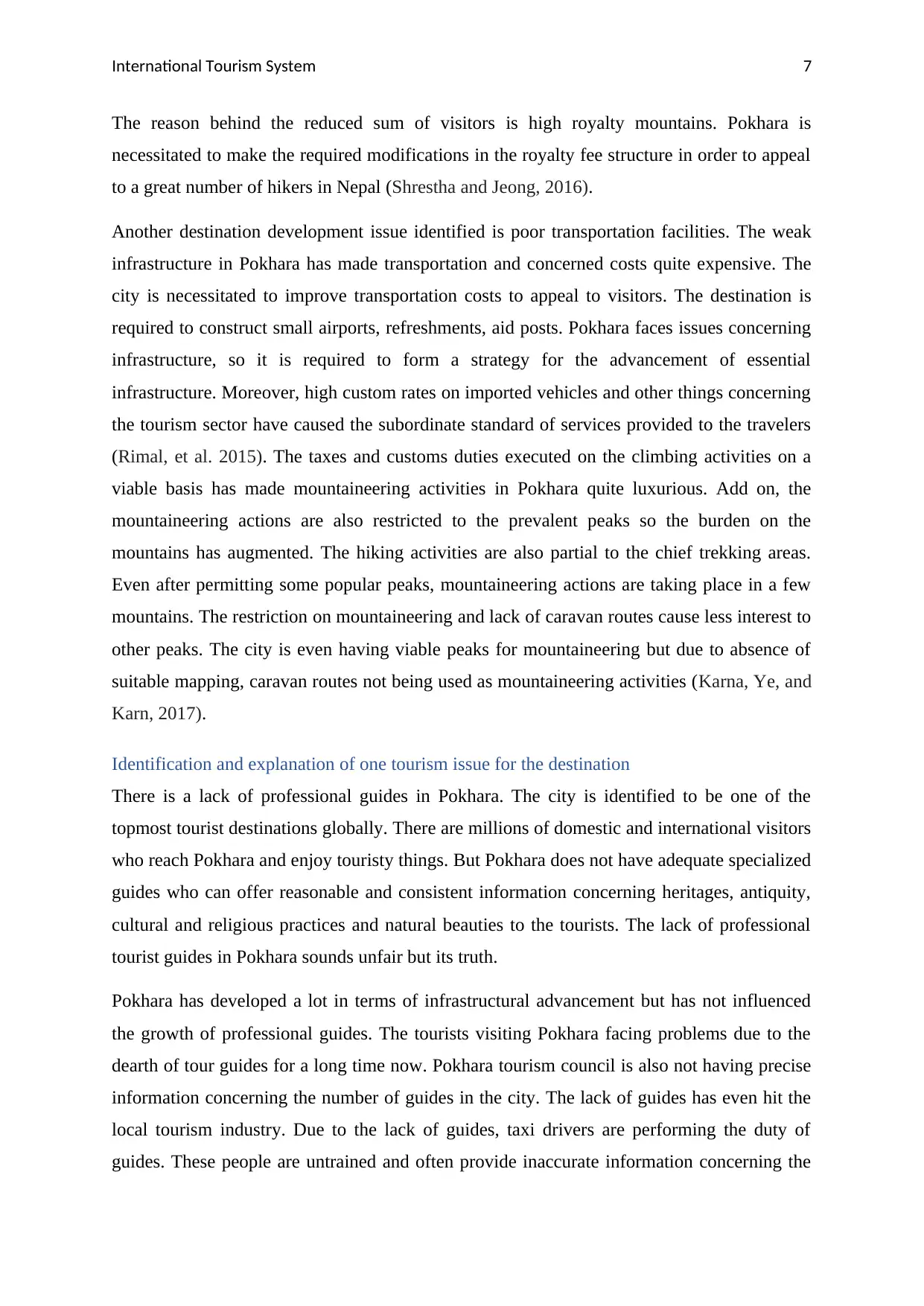
International Tourism System 7
The reason behind the reduced sum of visitors is high royalty mountains. Pokhara is
necessitated to make the required modifications in the royalty fee structure in order to appeal
to a great number of hikers in Nepal (Shrestha and Jeong, 2016).
Another destination development issue identified is poor transportation facilities. The weak
infrastructure in Pokhara has made transportation and concerned costs quite expensive. The
city is necessitated to improve transportation costs to appeal to visitors. The destination is
required to construct small airports, refreshments, aid posts. Pokhara faces issues concerning
infrastructure, so it is required to form a strategy for the advancement of essential
infrastructure. Moreover, high custom rates on imported vehicles and other things concerning
the tourism sector have caused the subordinate standard of services provided to the travelers
(Rimal, et al. 2015). The taxes and customs duties executed on the climbing activities on a
viable basis has made mountaineering activities in Pokhara quite luxurious. Add on, the
mountaineering actions are also restricted to the prevalent peaks so the burden on the
mountains has augmented. The hiking activities are also partial to the chief trekking areas.
Even after permitting some popular peaks, mountaineering actions are taking place in a few
mountains. The restriction on mountaineering and lack of caravan routes cause less interest to
other peaks. The city is even having viable peaks for mountaineering but due to absence of
suitable mapping, caravan routes not being used as mountaineering activities (Karna, Ye, and
Karn, 2017).
Identification and explanation of one tourism issue for the destination
There is a lack of professional guides in Pokhara. The city is identified to be one of the
topmost tourist destinations globally. There are millions of domestic and international visitors
who reach Pokhara and enjoy touristy things. But Pokhara does not have adequate specialized
guides who can offer reasonable and consistent information concerning heritages, antiquity,
cultural and religious practices and natural beauties to the tourists. The lack of professional
tourist guides in Pokhara sounds unfair but its truth.
Pokhara has developed a lot in terms of infrastructural advancement but has not influenced
the growth of professional guides. The tourists visiting Pokhara facing problems due to the
dearth of tour guides for a long time now. Pokhara tourism council is also not having precise
information concerning the number of guides in the city. The lack of guides has even hit the
local tourism industry. Due to the lack of guides, taxi drivers are performing the duty of
guides. These people are untrained and often provide inaccurate information concerning the
The reason behind the reduced sum of visitors is high royalty mountains. Pokhara is
necessitated to make the required modifications in the royalty fee structure in order to appeal
to a great number of hikers in Nepal (Shrestha and Jeong, 2016).
Another destination development issue identified is poor transportation facilities. The weak
infrastructure in Pokhara has made transportation and concerned costs quite expensive. The
city is necessitated to improve transportation costs to appeal to visitors. The destination is
required to construct small airports, refreshments, aid posts. Pokhara faces issues concerning
infrastructure, so it is required to form a strategy for the advancement of essential
infrastructure. Moreover, high custom rates on imported vehicles and other things concerning
the tourism sector have caused the subordinate standard of services provided to the travelers
(Rimal, et al. 2015). The taxes and customs duties executed on the climbing activities on a
viable basis has made mountaineering activities in Pokhara quite luxurious. Add on, the
mountaineering actions are also restricted to the prevalent peaks so the burden on the
mountains has augmented. The hiking activities are also partial to the chief trekking areas.
Even after permitting some popular peaks, mountaineering actions are taking place in a few
mountains. The restriction on mountaineering and lack of caravan routes cause less interest to
other peaks. The city is even having viable peaks for mountaineering but due to absence of
suitable mapping, caravan routes not being used as mountaineering activities (Karna, Ye, and
Karn, 2017).
Identification and explanation of one tourism issue for the destination
There is a lack of professional guides in Pokhara. The city is identified to be one of the
topmost tourist destinations globally. There are millions of domestic and international visitors
who reach Pokhara and enjoy touristy things. But Pokhara does not have adequate specialized
guides who can offer reasonable and consistent information concerning heritages, antiquity,
cultural and religious practices and natural beauties to the tourists. The lack of professional
tourist guides in Pokhara sounds unfair but its truth.
Pokhara has developed a lot in terms of infrastructural advancement but has not influenced
the growth of professional guides. The tourists visiting Pokhara facing problems due to the
dearth of tour guides for a long time now. Pokhara tourism council is also not having precise
information concerning the number of guides in the city. The lack of guides has even hit the
local tourism industry. Due to the lack of guides, taxi drivers are performing the duty of
guides. These people are untrained and often provide inaccurate information concerning the
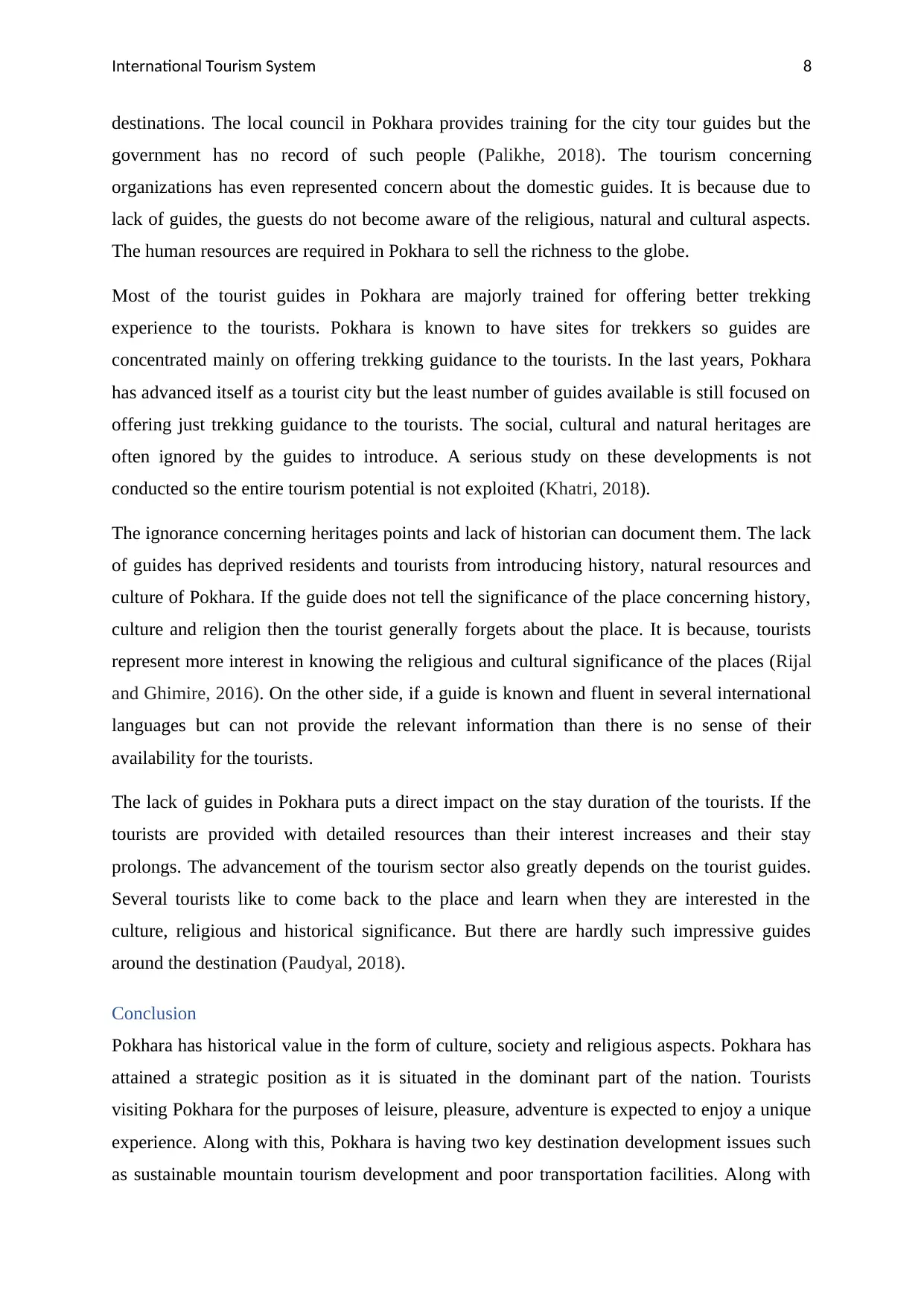
International Tourism System 8
destinations. The local council in Pokhara provides training for the city tour guides but the
government has no record of such people (Palikhe, 2018). The tourism concerning
organizations has even represented concern about the domestic guides. It is because due to
lack of guides, the guests do not become aware of the religious, natural and cultural aspects.
The human resources are required in Pokhara to sell the richness to the globe.
Most of the tourist guides in Pokhara are majorly trained for offering better trekking
experience to the tourists. Pokhara is known to have sites for trekkers so guides are
concentrated mainly on offering trekking guidance to the tourists. In the last years, Pokhara
has advanced itself as a tourist city but the least number of guides available is still focused on
offering just trekking guidance to the tourists. The social, cultural and natural heritages are
often ignored by the guides to introduce. A serious study on these developments is not
conducted so the entire tourism potential is not exploited (Khatri, 2018).
The ignorance concerning heritages points and lack of historian can document them. The lack
of guides has deprived residents and tourists from introducing history, natural resources and
culture of Pokhara. If the guide does not tell the significance of the place concerning history,
culture and religion then the tourist generally forgets about the place. It is because, tourists
represent more interest in knowing the religious and cultural significance of the places (Rijal
and Ghimire, 2016). On the other side, if a guide is known and fluent in several international
languages but can not provide the relevant information than there is no sense of their
availability for the tourists.
The lack of guides in Pokhara puts a direct impact on the stay duration of the tourists. If the
tourists are provided with detailed resources than their interest increases and their stay
prolongs. The advancement of the tourism sector also greatly depends on the tourist guides.
Several tourists like to come back to the place and learn when they are interested in the
culture, religious and historical significance. But there are hardly such impressive guides
around the destination (Paudyal, 2018).
Conclusion
Pokhara has historical value in the form of culture, society and religious aspects. Pokhara has
attained a strategic position as it is situated in the dominant part of the nation. Tourists
visiting Pokhara for the purposes of leisure, pleasure, adventure is expected to enjoy a unique
experience. Along with this, Pokhara is having two key destination development issues such
as sustainable mountain tourism development and poor transportation facilities. Along with
destinations. The local council in Pokhara provides training for the city tour guides but the
government has no record of such people (Palikhe, 2018). The tourism concerning
organizations has even represented concern about the domestic guides. It is because due to
lack of guides, the guests do not become aware of the religious, natural and cultural aspects.
The human resources are required in Pokhara to sell the richness to the globe.
Most of the tourist guides in Pokhara are majorly trained for offering better trekking
experience to the tourists. Pokhara is known to have sites for trekkers so guides are
concentrated mainly on offering trekking guidance to the tourists. In the last years, Pokhara
has advanced itself as a tourist city but the least number of guides available is still focused on
offering just trekking guidance to the tourists. The social, cultural and natural heritages are
often ignored by the guides to introduce. A serious study on these developments is not
conducted so the entire tourism potential is not exploited (Khatri, 2018).
The ignorance concerning heritages points and lack of historian can document them. The lack
of guides has deprived residents and tourists from introducing history, natural resources and
culture of Pokhara. If the guide does not tell the significance of the place concerning history,
culture and religion then the tourist generally forgets about the place. It is because, tourists
represent more interest in knowing the religious and cultural significance of the places (Rijal
and Ghimire, 2016). On the other side, if a guide is known and fluent in several international
languages but can not provide the relevant information than there is no sense of their
availability for the tourists.
The lack of guides in Pokhara puts a direct impact on the stay duration of the tourists. If the
tourists are provided with detailed resources than their interest increases and their stay
prolongs. The advancement of the tourism sector also greatly depends on the tourist guides.
Several tourists like to come back to the place and learn when they are interested in the
culture, religious and historical significance. But there are hardly such impressive guides
around the destination (Paudyal, 2018).
Conclusion
Pokhara has historical value in the form of culture, society and religious aspects. Pokhara has
attained a strategic position as it is situated in the dominant part of the nation. Tourists
visiting Pokhara for the purposes of leisure, pleasure, adventure is expected to enjoy a unique
experience. Along with this, Pokhara is having two key destination development issues such
as sustainable mountain tourism development and poor transportation facilities. Along with
⊘ This is a preview!⊘
Do you want full access?
Subscribe today to unlock all pages.

Trusted by 1+ million students worldwide

International Tourism System 9
this, there is one relevant tourism issue in Pokhara like a lack of professional guides in
Pokhara. Pokhara is not having adequate professional guides who can offer impartial and
consistent information. But this issue can be resolved through the government’s active
participation.
this, there is one relevant tourism issue in Pokhara like a lack of professional guides in
Pokhara. Pokhara is not having adequate professional guides who can offer impartial and
consistent information. But this issue can be resolved through the government’s active
participation.
Paraphrase This Document
Need a fresh take? Get an instant paraphrase of this document with our AI Paraphraser
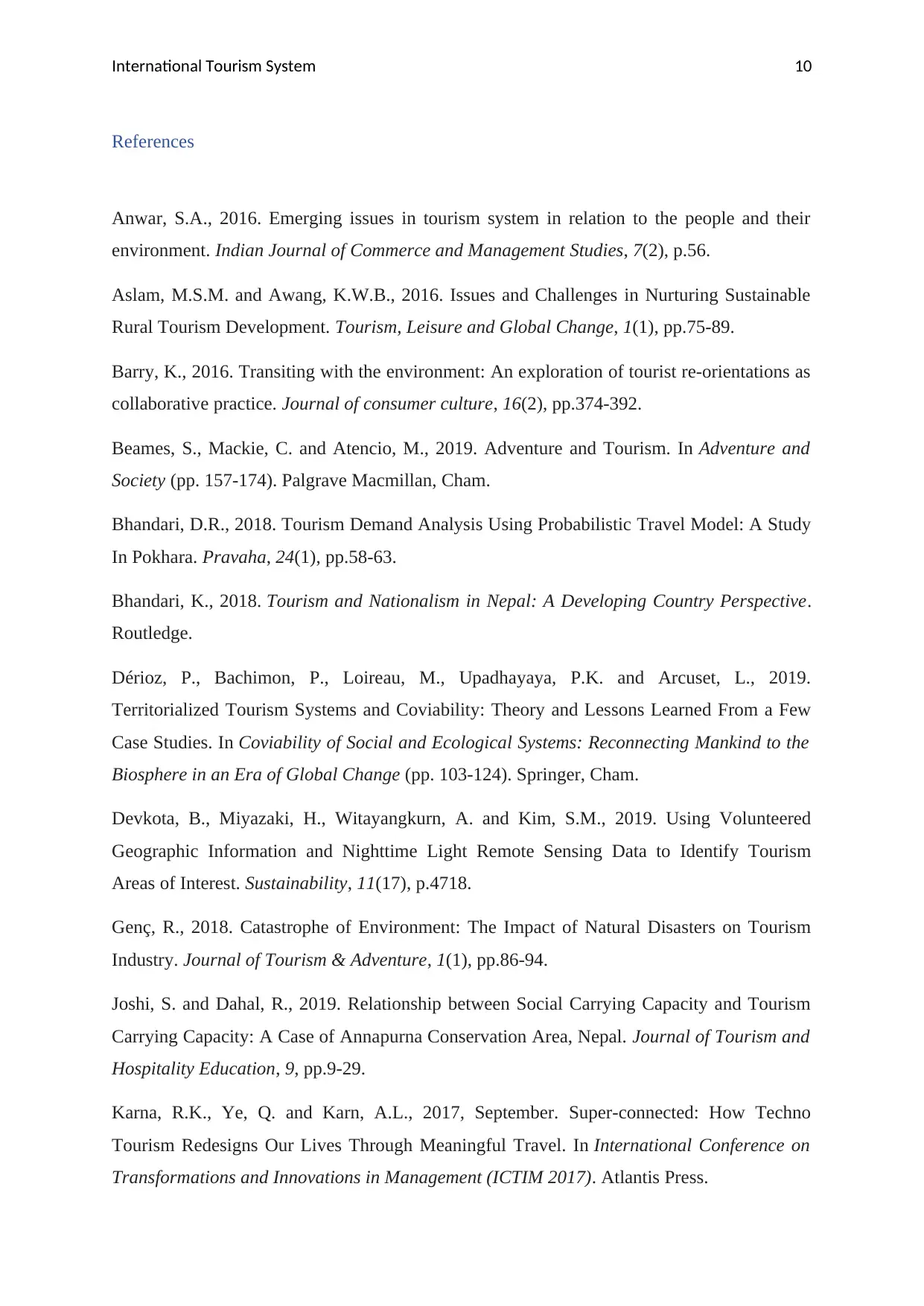
International Tourism System 10
References
Anwar, S.A., 2016. Emerging issues in tourism system in relation to the people and their
environment. Indian Journal of Commerce and Management Studies, 7(2), p.56.
Aslam, M.S.M. and Awang, K.W.B., 2016. Issues and Challenges in Nurturing Sustainable
Rural Tourism Development. Tourism, Leisure and Global Change, 1(1), pp.75-89.
Barry, K., 2016. Transiting with the environment: An exploration of tourist re-orientations as
collaborative practice. Journal of consumer culture, 16(2), pp.374-392.
Beames, S., Mackie, C. and Atencio, M., 2019. Adventure and Tourism. In Adventure and
Society (pp. 157-174). Palgrave Macmillan, Cham.
Bhandari, D.R., 2018. Tourism Demand Analysis Using Probabilistic Travel Model: A Study
In Pokhara. Pravaha, 24(1), pp.58-63.
Bhandari, K., 2018. Tourism and Nationalism in Nepal: A Developing Country Perspective.
Routledge.
Dérioz, P., Bachimon, P., Loireau, M., Upadhayaya, P.K. and Arcuset, L., 2019.
Territorialized Tourism Systems and Coviability: Theory and Lessons Learned From a Few
Case Studies. In Coviability of Social and Ecological Systems: Reconnecting Mankind to the
Biosphere in an Era of Global Change (pp. 103-124). Springer, Cham.
Devkota, B., Miyazaki, H., Witayangkurn, A. and Kim, S.M., 2019. Using Volunteered
Geographic Information and Nighttime Light Remote Sensing Data to Identify Tourism
Areas of Interest. Sustainability, 11(17), p.4718.
Genç, R., 2018. Catastrophe of Environment: The Impact of Natural Disasters on Tourism
Industry. Journal of Tourism & Adventure, 1(1), pp.86-94.
Joshi, S. and Dahal, R., 2019. Relationship between Social Carrying Capacity and Tourism
Carrying Capacity: A Case of Annapurna Conservation Area, Nepal. Journal of Tourism and
Hospitality Education, 9, pp.9-29.
Karna, R.K., Ye, Q. and Karn, A.L., 2017, September. Super-connected: How Techno
Tourism Redesigns Our Lives Through Meaningful Travel. In International Conference on
Transformations and Innovations in Management (ICTIM 2017). Atlantis Press.
References
Anwar, S.A., 2016. Emerging issues in tourism system in relation to the people and their
environment. Indian Journal of Commerce and Management Studies, 7(2), p.56.
Aslam, M.S.M. and Awang, K.W.B., 2016. Issues and Challenges in Nurturing Sustainable
Rural Tourism Development. Tourism, Leisure and Global Change, 1(1), pp.75-89.
Barry, K., 2016. Transiting with the environment: An exploration of tourist re-orientations as
collaborative practice. Journal of consumer culture, 16(2), pp.374-392.
Beames, S., Mackie, C. and Atencio, M., 2019. Adventure and Tourism. In Adventure and
Society (pp. 157-174). Palgrave Macmillan, Cham.
Bhandari, D.R., 2018. Tourism Demand Analysis Using Probabilistic Travel Model: A Study
In Pokhara. Pravaha, 24(1), pp.58-63.
Bhandari, K., 2018. Tourism and Nationalism in Nepal: A Developing Country Perspective.
Routledge.
Dérioz, P., Bachimon, P., Loireau, M., Upadhayaya, P.K. and Arcuset, L., 2019.
Territorialized Tourism Systems and Coviability: Theory and Lessons Learned From a Few
Case Studies. In Coviability of Social and Ecological Systems: Reconnecting Mankind to the
Biosphere in an Era of Global Change (pp. 103-124). Springer, Cham.
Devkota, B., Miyazaki, H., Witayangkurn, A. and Kim, S.M., 2019. Using Volunteered
Geographic Information and Nighttime Light Remote Sensing Data to Identify Tourism
Areas of Interest. Sustainability, 11(17), p.4718.
Genç, R., 2018. Catastrophe of Environment: The Impact of Natural Disasters on Tourism
Industry. Journal of Tourism & Adventure, 1(1), pp.86-94.
Joshi, S. and Dahal, R., 2019. Relationship between Social Carrying Capacity and Tourism
Carrying Capacity: A Case of Annapurna Conservation Area, Nepal. Journal of Tourism and
Hospitality Education, 9, pp.9-29.
Karna, R.K., Ye, Q. and Karn, A.L., 2017, September. Super-connected: How Techno
Tourism Redesigns Our Lives Through Meaningful Travel. In International Conference on
Transformations and Innovations in Management (ICTIM 2017). Atlantis Press.

International Tourism System 11
Khatri, I., 2018. New Trends in Adventure Tourism: A Lesson from 6th International
Adventure Conference, 30 January-2 February 2018, Segovia, Spain. Journal of Tourism &
Adventure, 1(1), pp.106-114.
Palikhe, A., 2018. Women Empowerment in Tourism: Special Reference to Pokhara
Metropolitan City. Journal of Nepalese Business Studies, 11(1), pp.35-44.
Paudyal, N.P., 2018. Trends and Major Attractions of Tourism in Nepal. Invention Journal of
Research Technology in Engineering & Management, 51, 59.
Rijal, C.P. and Ghimire, S., 2016. Prospects of creating memorable experience in Nepalese
tourism and hospitality industry. Journal of Tourism and Hospitality Education, 6, pp.40-66.
Rimal, B., Baral, H., Stork, N., Paudyal, K. and Rijal, S., 2015. Growing city and rapid land
use transition: assessing multiple hazards and risks in the Pokhara Valley, Nepal. Land, 4(4),
pp.957-978.
Shrestha, D. and Jeong, S.R., 2016. An ICT Framework for Tourism Industry of Nepal:
Prospect and Challenges. Journal of Internet Computing and Services (JICS), 6, pp.113-122.
Singagerda, F.S. and Aeni, N., 2017. International Tourism Trade Flows and the Impact of
Indonesian Tourism. International Journal of Business and Management, 7(2), pp.317-335.
Upadhayaya, P., 2015. Sustainability threats to mountain tourism with tourist mechanizes
mobility induced global warming: A case study of Nepal. Journal of Tourism and
Hospitality, 4(2), pp.2167-0269.
Upadhyay, P., 2019. Tourism in Nepal, Real or Hyperreal: A Postmodern Perspective. NUTA
Journal, 6(1-2), pp.39-46.
Upadhyay, P., 2019. Tourism Policy of Nepal and Sustainable Mountain Tourism
Development in Retrospect. The Gaze: Journal of Tourism and Hospitality, 10(1), pp.37-50.
Khatri, I., 2018. New Trends in Adventure Tourism: A Lesson from 6th International
Adventure Conference, 30 January-2 February 2018, Segovia, Spain. Journal of Tourism &
Adventure, 1(1), pp.106-114.
Palikhe, A., 2018. Women Empowerment in Tourism: Special Reference to Pokhara
Metropolitan City. Journal of Nepalese Business Studies, 11(1), pp.35-44.
Paudyal, N.P., 2018. Trends and Major Attractions of Tourism in Nepal. Invention Journal of
Research Technology in Engineering & Management, 51, 59.
Rijal, C.P. and Ghimire, S., 2016. Prospects of creating memorable experience in Nepalese
tourism and hospitality industry. Journal of Tourism and Hospitality Education, 6, pp.40-66.
Rimal, B., Baral, H., Stork, N., Paudyal, K. and Rijal, S., 2015. Growing city and rapid land
use transition: assessing multiple hazards and risks in the Pokhara Valley, Nepal. Land, 4(4),
pp.957-978.
Shrestha, D. and Jeong, S.R., 2016. An ICT Framework for Tourism Industry of Nepal:
Prospect and Challenges. Journal of Internet Computing and Services (JICS), 6, pp.113-122.
Singagerda, F.S. and Aeni, N., 2017. International Tourism Trade Flows and the Impact of
Indonesian Tourism. International Journal of Business and Management, 7(2), pp.317-335.
Upadhayaya, P., 2015. Sustainability threats to mountain tourism with tourist mechanizes
mobility induced global warming: A case study of Nepal. Journal of Tourism and
Hospitality, 4(2), pp.2167-0269.
Upadhyay, P., 2019. Tourism in Nepal, Real or Hyperreal: A Postmodern Perspective. NUTA
Journal, 6(1-2), pp.39-46.
Upadhyay, P., 2019. Tourism Policy of Nepal and Sustainable Mountain Tourism
Development in Retrospect. The Gaze: Journal of Tourism and Hospitality, 10(1), pp.37-50.
⊘ This is a preview!⊘
Do you want full access?
Subscribe today to unlock all pages.

Trusted by 1+ million students worldwide
1 out of 12
Related Documents
Your All-in-One AI-Powered Toolkit for Academic Success.
+13062052269
info@desklib.com
Available 24*7 on WhatsApp / Email
![[object Object]](/_next/static/media/star-bottom.7253800d.svg)
Unlock your academic potential
Copyright © 2020–2025 A2Z Services. All Rights Reserved. Developed and managed by ZUCOL.





